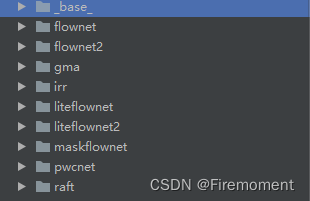
————————————————————————————————————————————
最近在研究微表情识别领域,在研究光流特征时接触到openmmlab,这个框架集成了许多深度学习模型,我将后续继续学习,我先介绍openmmlab下的mmflow,它集成了目前主流的深度学习光流框架,可以直接上手使用,非常方便
mmflow代码下载地址:https://github.com/open-mmlab/mmflow
配置文件结构
- 在config/_base_下有四个基本组件:datasets,models,schedules,default_runtime
_base_下的文件称为原始配置文件,推荐只使用一个原始文件,剩下的配置文件继承这个原始配置文件,最大的继承等级为3,比如使用pwcnet结构:_base_ = ../pwcnet/pwcnet_slong_8x1_flyingchairs_384x448.py
也可以自己创建架构,命名规则如下
命名规则
-{model}_{schedule}_[gpu x batch_per_gpu]_{training datasets}_[input_size].py {xx}是必须的,[yyy]是可选的
- model:模型类型,如pwcnet
- schedule:训练安排,如slong,sfine,sshort或者迭代次数如150k
- gpu * batch_per_gpu:gpu情况,如8*1
- training datasets:数据集,如flyingchairs
- input_size:输入图片大小
示例
使用pwcnet网络,flyingchairs数据集,采用slong策略,默认运行时间
_base_ = [
'../_base_/models/pwcnet.py', '../_base_/datasets/flyingchairs_384x448.py',
'../_base_/schedules/schedule_s_long.py', '../_base_/default_runtime.py'
]
其中models下的pwcnet.py是基本模型结构,如下
model = dict(
type='PWCNet', # The algorithm name
encoder=dict( # Encoder module config
type='PWCNetEncoder', # The name of encoder in PWC-Net.
in_channels=3, # The input channels
# The type of this sub-module, if net_type is Basic, the the number of convolution layers of each level is 3,
# if net_type is Small, the the number of convolution layers of each level is 2.
net_type='Basic',
pyramid_levels=[
'level1', 'level2', 'level3', 'level4', 'level5', 'level6'
], # The list of feature pyramid levels that are the keys for output dict.
out_channels=(16, 32, 64, 96, 128, 196), # List of numbers of output channels of each pyramid level.
strides=(2, 2, 2, 2, 2, 2), # List of strides of each pyramid level.
dilations=(1, 1, 1, 1, 1, 1), # List of dilation of each pyramid level.
act_cfg=dict(type='LeakyReLU', negative_slope=0.1)), # Config dict for each activation layer in ConvModule.
decoder=dict( # Decoder module config.
type='PWCNetDecoder', # The name of flow decoder in PWC-Net.
in_channels=dict(
level6=81, level5=213, level4=181, level3=149, level2=117), # Input channels of basic dense block.
flow_div=20., # The constant divisor to scale the ground truth value.
corr_cfg=dict(type='Correlation', max_displacement=4, padding=0),
warp_cfg=dict(type='Warp'),
act_cfg=dict(type='LeakyReLU', negative_slope=0.1),
scaled=False, # Whether to use scaled correlation by the number of elements involved to calculate correlation or not.
post_processor=dict(type='ContextNet', in_channels=565), # The configuration for post processor.
flow_loss=dict( # The loss function configuration.
type='MultiLevelEPE',
p=2,
reduction='sum',
weights={ # The weights for different levels of flow.
'level2': 0.005,
'level3': 0.01,
'level4': 0.02,
'level5': 0.08,
'level6': 0.32
}),
),
# model training and testing settings
train_cfg=dict(),
test_cfg=dict(),
init_cfg=dict(
type='Kaiming',
nonlinearity='leaky_relu',
layer=['Conv2d', 'ConvTranspose2d'],
mode='fan_in',
bias=0))
datasets/flycharis数据集结构如下
dataset_type = 'FlyingChairs' # Dataset name
data_root = 'data/FlyingChairs/data' # Root path of dataset
img_norm_cfg = dict(mean=[0., 0., 0.], std=[255., 255., 255], to_rgb=False) # Image normalization config to normalize the input images
train_pipeline = [ # Training pipeline
dict(type='LoadImageFromFile'), # load images
dict(type='LoadAnnotations'), # load flow data
dict(type='ColorJitter', # Randomly change the brightness, contrast, saturation and hue of an image.
brightness=0.5, # How much to jitter brightness.
contrast=0.5, # How much to jitter contrast.
saturation=0.5, # How much to jitter saturation.
hue=0.5), # How much to jitter hue.
dict(type='RandomGamma', gamma_range=(0.7, 1.5)), # Randomly gamma correction on images.
dict(type='Normalize', **img_norm_cfg), # Normalization config, the values are from img_norm_cfg
dict(type='GaussianNoise', sigma_range=(0, 0.04), clamp_range=(0., 1.)), # Add Gaussian noise and a sigma uniformly sampled from [0, 0.04];
dict(type='RandomFlip', prob=0.5, direction='horizontal'), # Random horizontal flip
dict(type='RandomFlip', prob=0.5, direction='vertical'), # Random vertical flip
# Random affine transformation of images
# Keys of global_transform and relative_transform should be the subset of
# ('translates', 'zoom', 'shear', 'rotate'). And also, each key and its
# corresponding values has to satisfy the following rules:
# - translates: the translation ratios along x axis and y axis. Defaults
# to(0., 0.).
# - zoom: the min and max zoom ratios. Defaults to (1.0, 1.0).
# - shear: the min and max shear ratios. Defaults to (1.0, 1.0).
# - rotate: the min and max rotate degree. Defaults to (0., 0.).
dict(type='RandomAffine',
global_transform=dict(
translates=(0.05, 0.05),
zoom=(1.0, 1.5),
shear=(0.86, 1.16),
rotate=(-10., 10.)
),
relative_transform=dict(
translates=(0.00375, 0.00375),
zoom=(0.985, 1.015),
shear=(1.0, 1.0),
rotate=(-1.0, 1.0)
)),
dict(type='RandomCrop', crop_size=(384, 448)), # Random crop the image and flow as (384, 448)
dict(type='DefaultFormatBundle'), # It simplifies the pipeline of formatting common fields, including "img1", "img2" and "flow_gt".
dict(
type='Collect', # Collect data from the loader relevant to the specific task.
keys=['imgs', 'flow_gt'],
meta_keys=('img_fields', 'ann_fields', 'filename1', 'filename2',
'ori_filename1', 'ori_filename2', 'filename_flow',
'ori_filename_flow', 'ori_shape', 'img_shape',
'img_norm_cfg')),
]
test_pipeline = [
dict(type='LoadImageFromFile'),
dict(type='LoadAnnotations'),
dict(type='InputResize', exponent=4),
dict(type='Normalize', **img_norm_cfg),
dict(type='TestFormatBundle'), # It simplifies the pipeline of formatting common fields, including "img1"
# and "img2".
dict(
type='Collect',
keys=['imgs'], # Collect data from the loader relevant to the specific task.
meta_keys=('flow_gt', 'filename1', 'filename2', 'ori_filename1',
'ori_filename2', 'ori_shape', 'img_shape', 'img_norm_cfg',
'scale_factor', 'pad_shape')) # 'flow_gt' in img_meta is works for online evaluation.
]
data = dict(
train_dataloader=dict(
samples_per_gpu=1, # Batch size of a single GPU
workers_per_gpu=5, # Worker to pre-fetch data for each single GPU
drop_last=True), # Drops the last non-full batch
val_dataloader=dict(
samples_per_gpu=1, # Batch size of a single GPU
workers_per_gpu=2, # Worker to pre-fetch data for each single GPU
shuffle=False), # Whether shuffle dataset.
test_dataloader=dict(
samples_per_gpu=1, # Batch size of a single GPU
workers_per_gpu=2, # Worker to pre-fetch data for each single GPU
shuffle=False), # Whether shuffle dataset.
train=dict( # Train dataset config
type=dataset_type,
pipeline=train_pipeline,
data_root=data_root,
split_file='data/FlyingChairs_release/FlyingChairs_train_val.txt', # train-validation split file
),
val=dict(
type=dataset_type,
pipeline=test_pipeline,
data_root=data_root,
test_mode=True),
test=dict(
type=dataset_type,
pipeline=test_pipeline,
data_root=data_root,
test_mode=True)
)
schedules/schedule_s_longg.py如下
# optimizer
optimizer = dict(
type='Adam', lr=0.0001, weight_decay=0.0004, betas=(0.9, 0.999))
optimizer_config = dict(grad_clip=None)
# learning policy
lr_config = dict(
policy='step',
by_epoch=False,
gamma=0.5,
step=[400000, 600000, 800000, 1000000])
runner = dict(type='IterBasedRunner', max_iters=1200000)
checkpoint_config = dict(by_epoch=False, interval=100000)
evaluation = dict(interval=100000, metric='EPE')
default_runtime.py如下
log_config = dict( # config to register logger hook
interval=50, # Interval to print the log
hooks=[
dict(type='TextLoggerHook'),
dict(type='TensorboardLoggerHook')
]) # The logger used to record the training process.
dist_params = dict(backend='nccl') # Parameters to setup distributed training, the port can also be set.
log_level = 'INFO' # The level of logging.
load_from = None # load models as a pre-trained model from a given path. This will not resume training.
workflow = [('train', 1)] # Workflow for runner. [('train', 1)] means there is only one workflow and the workflow named 'train' is executed once.
对于不同的模型,mmflow都有对应的实现,复现起来就非常方便,如
通过参数修改配置
在tools/train.py或者test.py来训练或者测试代码,使用–cfg-options参数来做不同的配置
- 更新字典中的配置信息,如修改编码器输入通道数
--cfg-option model.encoder.in_channels=6 - 更新配置列表里的key,如data.train.pipeline一般是列表形式,"[dict(type=‘LoadImageFromFile’), …"如果想更新里面的某一个配置信息,把“LoadImageFromFile”更新为"LoadImageFromWebcam"可以使用
--cfg-options data.train.pipeline.0.type=LoadImageFromWebcam - 更新列表、元组的值,如更新“workflow=[(‘train’, 1)]”中的值
--cfg-options workflow="[(train,1),(val,1)]"注意使用双引号,而且不能有空格
以上便是mmflow文档中tutorials0的部分,因为官方文档的中文文档打不开,所以就自行做了笔记以便后期复习






















 1万+
1万+











 被折叠的 条评论
为什么被折叠?
被折叠的 条评论
为什么被折叠?








